traction control PONTIAC BONNEVILLE 1993 Owners Manual
[x] Cancel search | Manufacturer: PONTIAC, Model Year: 1993, Model line: BONNEVILLE, Model: PONTIAC BONNEVILLE 1993Pages: 322, PDF Size: 16.31 MB
Page 78 of 322
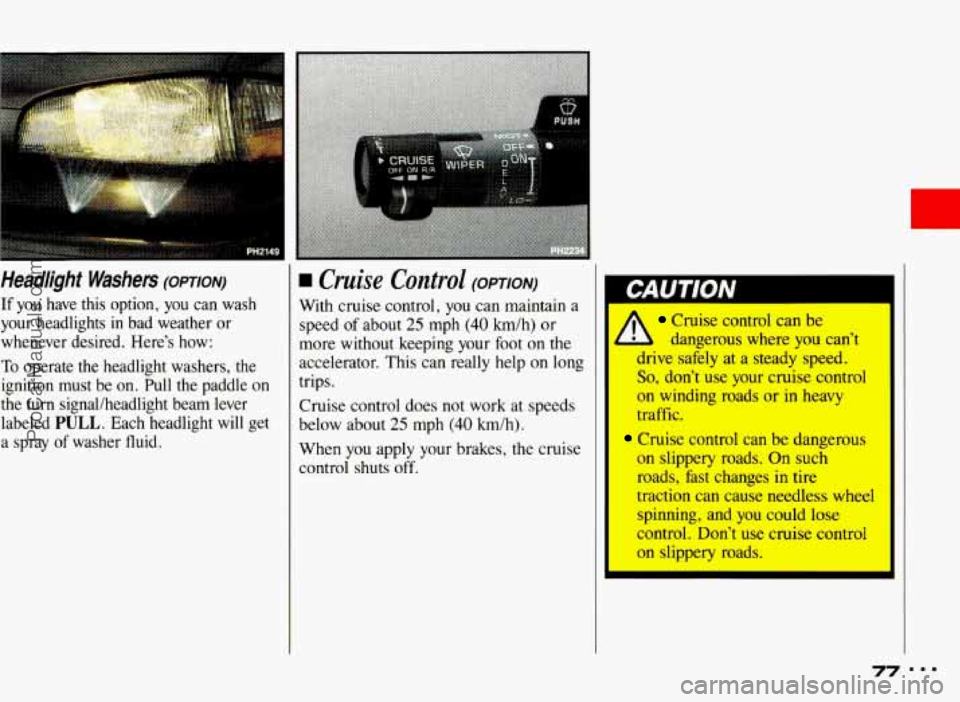
Headlight Washers (opT1oN)
If you have this option, you can wash
your headlights
in bad weather or
whenever desired. Here’s how:
To operate the headlight washers, the
ignition must be on. Pull the paddle on
the turn signal/headlight beam lever
labeled
PULL. Each headlight will get
a spray
of washer fluid.
H Cruise Control (OPTION)
With cruise control, you can maintain a
speed of about
25 mph (40 h/h) or
more without keeping your foot on the
accelerator. This can really help
on long
trips.
Cruise control does not work at speeds
1
below about 25 mph (40 km/h).
When you apply your brakes, the cruise
control shuts
off.
Cruise control can be
- b dangerous where you can’t
drive safely at a steady speed.
So, don’t use your cruise control
on winding roads or in heavy
traffic.
,Cruise control can be dangerous
on slippery roads. On such
roads, fast changes in tire
traction can cause needless wheel
spinning, and you could lose
control. Don’t use cruise control
on slippery mads.
77
ProCarManuals.com
Page 82 of 322
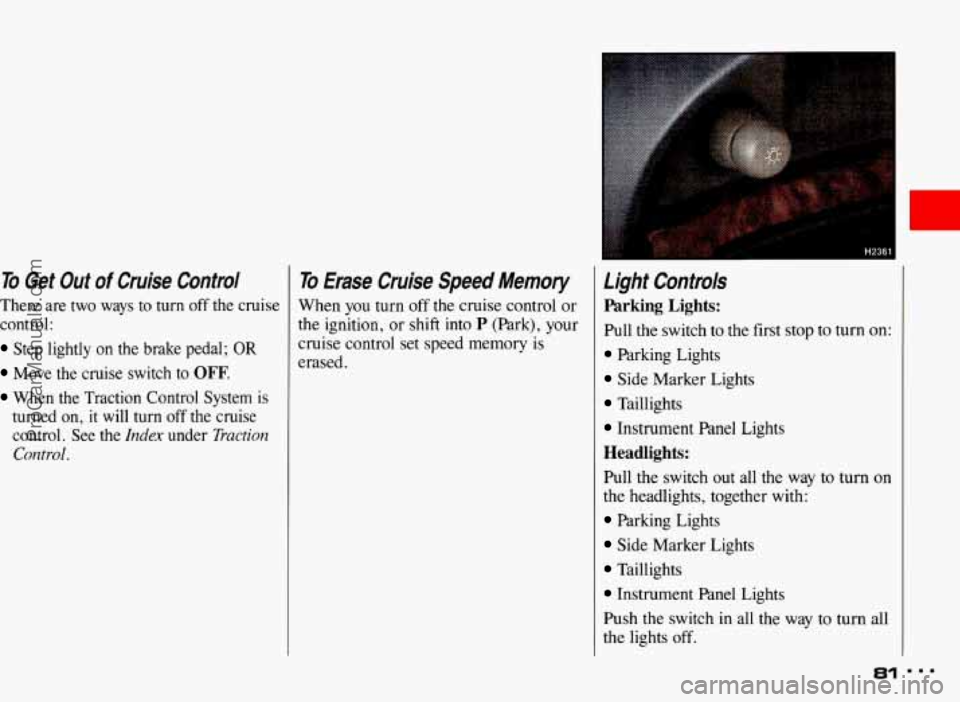
To Get Out of Cruise Control To Erase Cruise Speed Memory
There are two ways to turn off the cruise When you turn off the cruise control or
control: the ignition, or shift into
P (Park), your
Step lightly on the brake pedal; OR cruise control set speed is
Move the cruise switch to OFF.
When the Traction Control System is
turned on,
it will turn off the cruise
control. See the
Index under Tractiorz
Control.
erased.
Light Controls
Parking Lights:
Pull the switch to the first stop to turn on:
Parking Lights
Side Marker Lights
Taillights
Instrument Panel Lights
Headlights:
Pull the switch out all the way to turn on
the headlights, together with:
Parking Lights
Side Marker Lights
Taillights
Instrument Panel Lights
Push the switch in all the way to turn all
the lights
off.
81
ProCarManuals.com
Page 108 of 322
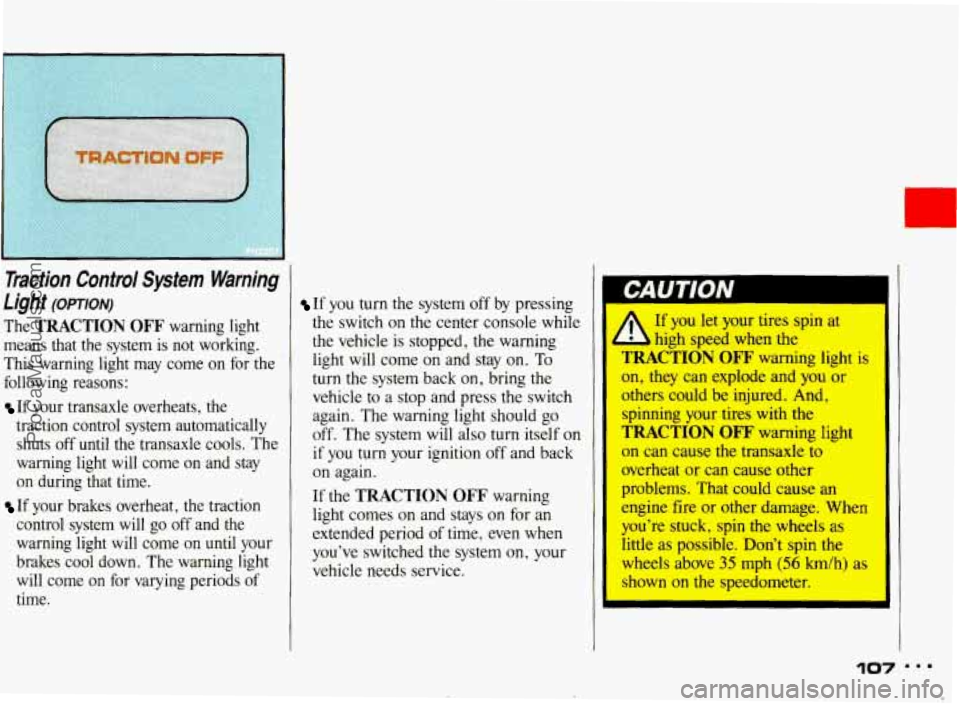
L
Traction Control System Warning
Light
(OPTION)
The TRACTION OFF warning light
means that the system is not working.
This warning light may come on for the
following reasons:
If your transaxle overheats, the
traction control system automatically shuts off
until the transaxle cools. The
warning light will come on and stay
on during that time.
If your brakes overheat, the traction
control system will go off and the
warning light will come
on until your
brakes cool down. The warning light
will come on for varying periods of
time.
If you turn the system off by pressing
the switch on the center console while
the vehicle is stopped, the warning
light will come on and stay on. To
turn the system back on, bring the
vehicle to
a stop and press the switch
again. The warning light should go
off. The system will also turn itself on
if you turn your ignition off and back
on again.
If the
TRACTION OFF warning
light comes on and stays on for an
extended period
of time, even when
you've switched the system on, your
vehicle needs service.
If you let your tires spin at
high sped when the
TRACTION OFF warning light is
on, they can explode and you or
othm could be injured. And,
spinning your tires with the
TRACTION OFF' warning light
on can cause the transaxle to
overheat or can cause other
problems. That could cause an
engine fire or other damage. When
you're stuck, spin the wheels as
little as possible. Don't spin the
wheels above 35 mph (56 h/h) as
shown on the speedometer.
e ProCarManuals.com
Page 109 of 322
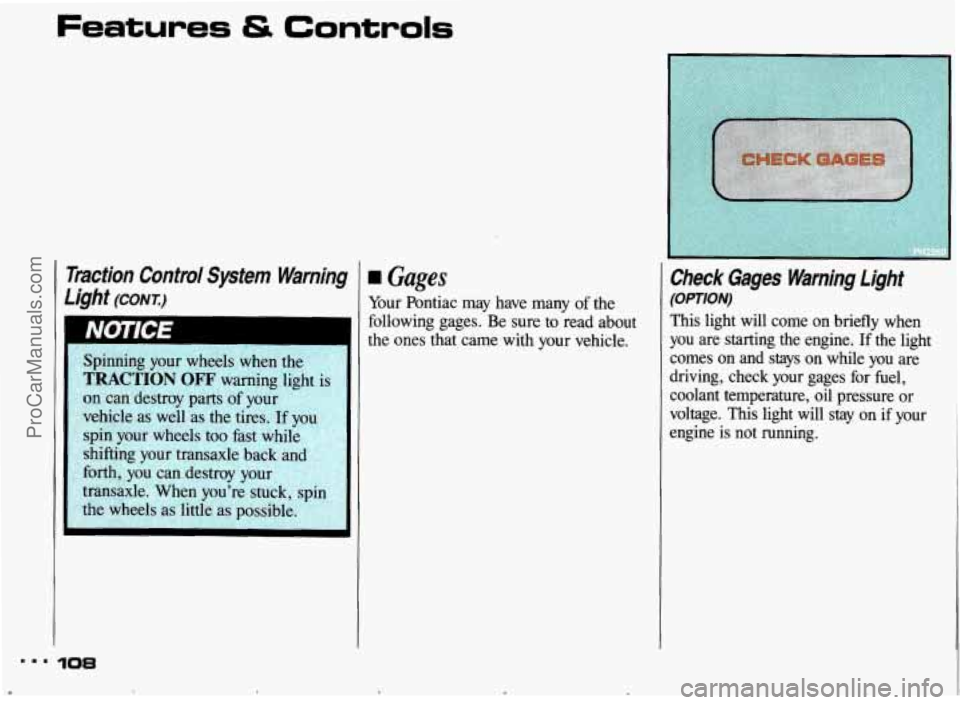
..I
.
Features & Controls
Id
Traction Control System Warning
Light (CONT.)
108
rn Gages
Your Pontiac may have many of the
following gages. Be sure to read about
the ones that came with your vehicle.
Check Gage5 Warning Light
(OPTION)
This light will come on briefly when
you
are starting the engine. If the light
comes
on and stays on while you are
driving, check your gages for fuel,
coolant temperature,
oil pressure or
voltage.
This light will stay on if your
engine
is not running.
ProCarManuals.com
Page 158 of 322
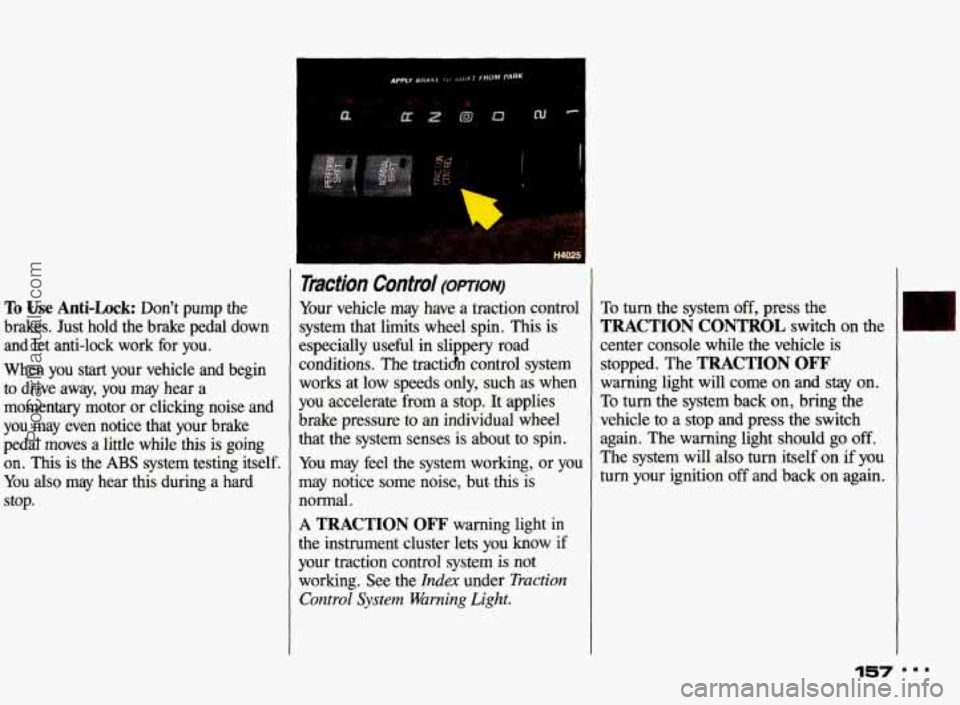
To Use Anti-Lock: Don't pump the
brakes. Just hold the brake pedal down
and let anti-lock work for you.
When you
start your vehicle and begin
to drive away, you may hear a
momentary motor
or clicking noise and
you may even notice that your brake
pedal
moves a little while this is going
on. This is the
ABS system testing itself.
You also may hear this during a hard
stop.
I--
Tiction Control (omm)
Your vehicle may have a traction control
system that limits wheel spin. This is
especially useful in slippery road
conditions. The tractidn control system
works at low speeds only, such as when
you accelerate from a stop. It applies
brake pressure
to an individual wheel
that the system senses is about to spin.
You may feel the system working, or you
may notice some noise, but. this is
normal.
A TRACTION OFF warning light in
the instrument cluster lets you know if
your traction control system
is not
working. See the
Index under Traction
Control
System Warning Light.
To turn the system off, press the
TRACTION CONTROL switch on the
center console while the vehicle is
stopped. The
TRACTION OFF
warning light will come on and stay on.
To turn the system back on, bring the
vehicle to a stop and press the switch
again. The warning light should
go off.
The system will also
turn itself on if you
turn your ignition off and back on again.
157
ProCarManuals.com
Page 161 of 322
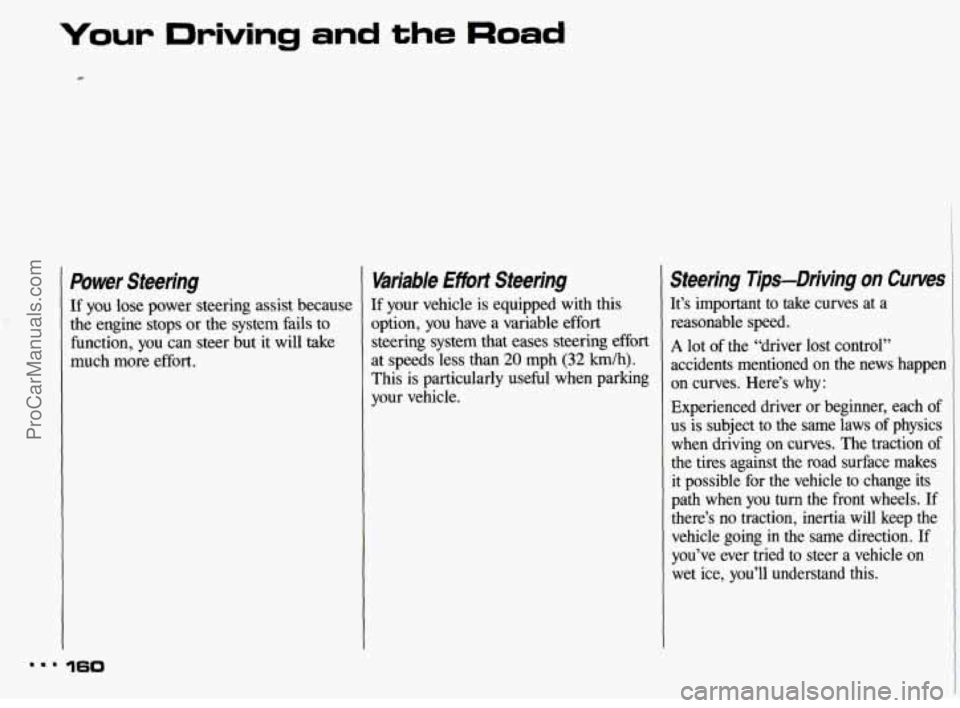
Your Driving and the Road
Power Steering
If you lose power steering assist because
the engine stops or the system fails to
function, you can steer but it will take
much more
effort.
Variable Effort Steering
If your vehicle is equipped with this
option, you have a variable effort
steering system that eases steering effort
at speeds less than
20 mph (32 Wh).
This is particularly useful when parking
your vehicle.
Steering Tips-Driving on Curves
It’s important to take curves at a reasonable speed.
A lot of the “driver lost control”
accidents mentioned on the news happen on curves. Here’s why:
Experienced driver or beginner, each of
us is subject to the same laws of physics
when driving on curves. The traction
of
the tires against the road surface makes
it possible for the vehicle to change
its
path when you turn the front wheels. If
there’s no traction, inertia will keep the vehicle going in the same direction.
If
you’ve ever tried to steer a vehicle on
wet ice, you’ll understand this.
mmm 160
ProCarManuals.com
Page 162 of 322
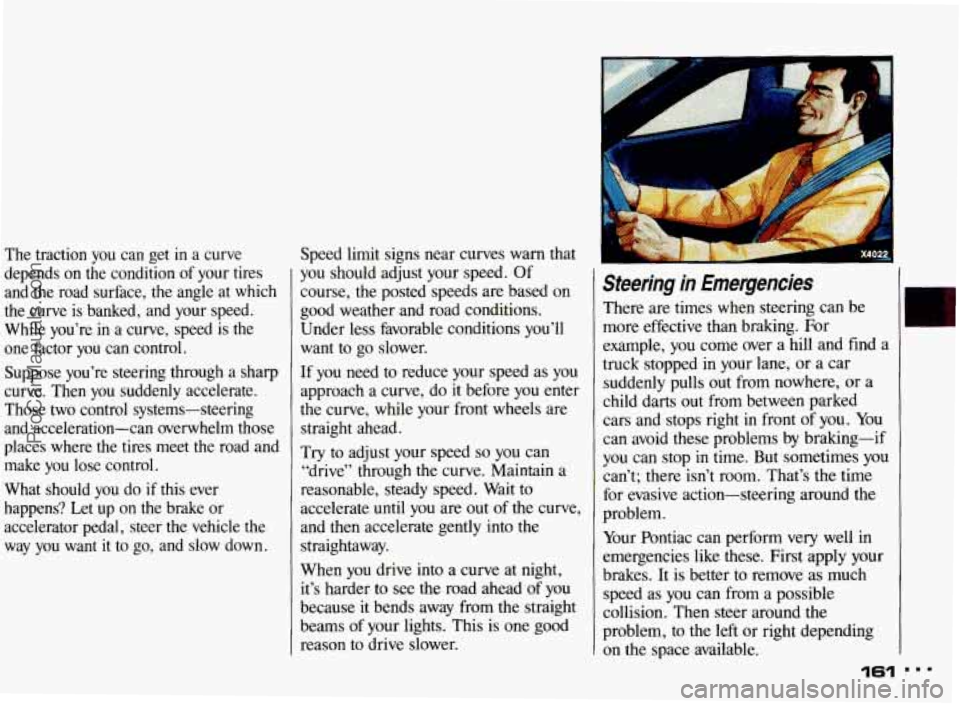
The traction you can get in a curve
depends on the condition of your tires
and the road surface,
the angle at which
the curve is banked, and your speed.
While you’re
in a curve, speed is the
one factor you can control.
Suppose you’re steering through a sharp
curve. Then you suddenly accelerate.
Those two control systems-steering
and acceleration-can overwhelm those
places where the tires meet the road and make you lose control.
What should you do if this ever
happens? Let up on
the brake or
accelerator pedal, steer the vehicle the
way you want it to go, and slow down. Speed limit signs near
curves warn that
you should adjust your speed. Of
course, the posted speeds are based on
good weather and road conditions.
Under less favorable conditions you’ll
want to go slower.
If you need to reduce your speed as you
approach a curve, do
it before you enter
the curve, while your front wheels are
straight ahead.
Try to adjust your speed
so you can
“drive” through the curve. Maintain a
reasonable, steady speed. Wait to
accelerate until you are out of the curve,
and then accelerate gently into the
straightaway.
When you drive into a curve at night,
it’s harder to see the road ahead of you
because it bends away from the straight
beams of your lights. This
is one good
reason to drive slower.
Steering in Emergencies
There are times when steering can be
more effective than braking. For
example, you come over a hill and find a
truck stopped in your lane, or a car
suddenly pulls out from nowhere, or a
child darts
out from between parked
cars and stops right in front of you. You
can avoid these problems by braking-if
you can stop
in time. But sometimes you
can’t; there isn’t room. That’s the time
for evasive action-steering around the
problem.
Your Pontiac can perform very well in
emergencies like these. First apply your
brakes.
It is better to remove as much
speed as you can from a possible
collision. Then steer around the
problem, to the left or right depending
on the space available.
161
ProCarManuals.com
Page 166 of 322
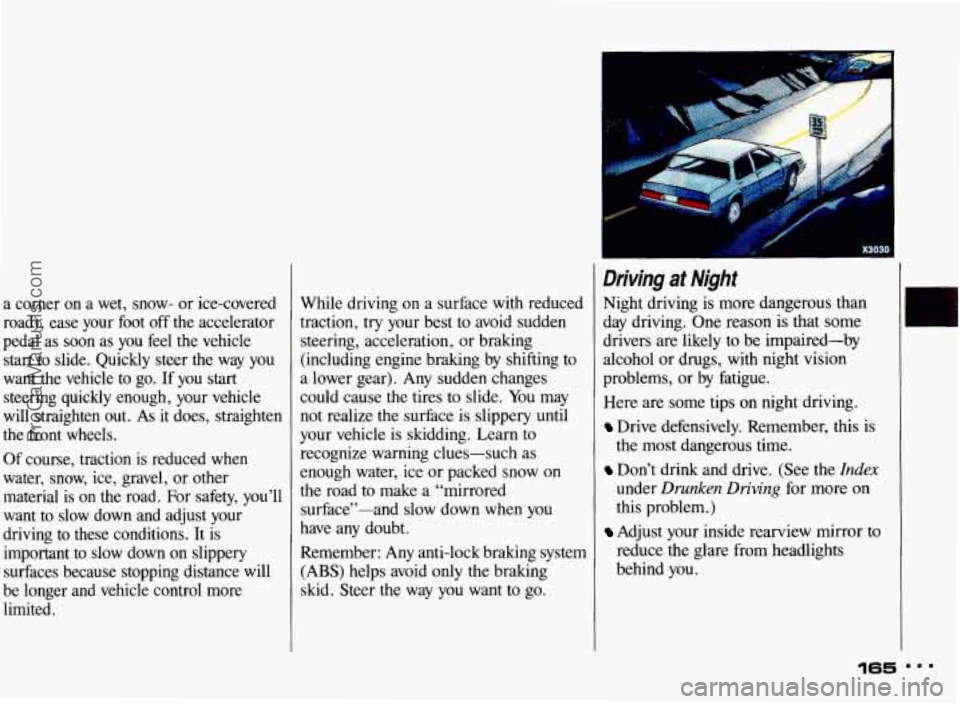
a corner on a wet, snow- or ice-covered
road), ease your foot off the accelerator
pedal as soon as you feel the vehicle
start to slide. Quickly steer the way you
want the vehicle to go. If you start
steering quickly enough, your vehicle
will straighten out. As it does, straighten
the front wheels.
Of course, traction is reduced when
water, snow, ice, gravel, or other
material is
on the road. For safety, you’ll
want to slow down and adjust your
driving to these conditions. It is
important to slow down on slippery
surfaces because stopping distance will
be longer and vehicle control more
limited. While
driving on a surface with reduced
traction, try your best
to avoid sudden
steering, acceleration, or braking
(including engine braking by shifting
to
a lower gear). Any sudden changes
could cause the tires to slide. You may
not realize the surface
is slippery until
your vehicle is skidding. Learn to
recognize warning clues-such as
enough water, ice
or packed snow on
the road to make a “mirrored
surface”-and slow down when
you
have any doubt.
Remember: Any anti-lock braking system
(ABS) helps avoid only the braking
slud. Steer the way you want to go.
Driving at Night
Night driving is more dangerous than
day driving. One reason is that some
drivers are likely to be impaired-by
alcohol or drugs, with night vision
problems, or by fatigue.
Here are some tips on night driving.
Drive defensively. Remember, this is
the most dangerous
time.
Don’t drink and drive. (See the Index
under Drunken Driving for more on
this problem.)
Adjust your inside rearview mirror to
reduce the glare from headlights
behind you.
165
ProCarManuals.com
Page 169 of 322
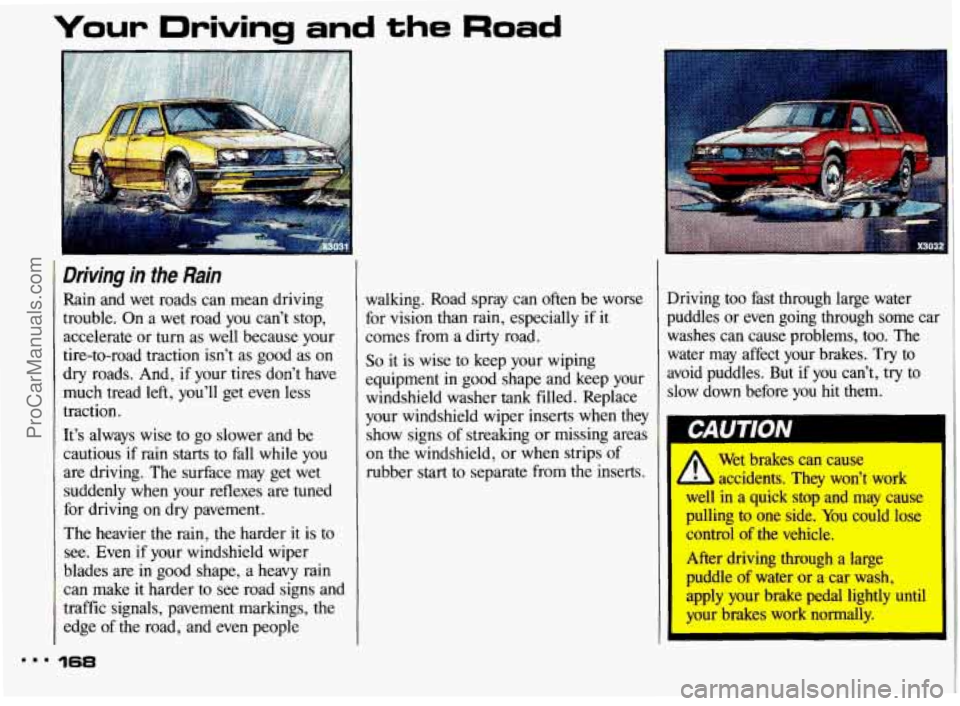
Your Driving and the Road
I
Driving in the Rain
Rain and wet roads can mean driving
trouble. On a wet road you can’t stop,
accelerate or turn as well because your
tire-to-road traction isn’t as good as on
dry roads. And,
if your tires don’t have
much tread
left, you’ll get even less
traction.
It’s always wise to go slower and be
cautious
if rain starts to fall while you
are driving. The surface may get wet
suddenly when your reflexes are tuned
for driving on dry pavement.
The heavier the rain, the harder
it is to
see. Even
if your windshield wiper
blades are
in good shape, a heavy rain
can make
it harder to see road signs and
traffic signals, pavement markings, the
edge of the road, and even people
168
walking. Road spray can often be worse
for vision than rain, especially
if it
comes from a dirty road.
So it is wise to keep your wiping
equipment
in good shape and keep your
windshield washer
tank filled. Replace
your windshield wiper inserts when they
show signs of streaking or missing areas
on the windshield, or when strips of
rubber start
to separate from the inserts. Driving too fast through large water
puddles
or even going through some car
washes can cause problems, too. The
water may affect your brakes. Try to
avoid puddles.
But if you can’t, try to
slow down before you hit them.
I
u I I(
Wet brakes can cause
l accidents. They won’t work
w in a quick stop and may cause
pulling to one side. You could lose
control
of the vehicle.
After driving through a large
puddle
of water or a car wash,
apply your brake pedal lightly
until
your brakes work normally.
ProCarManuals.com
Page 181 of 322
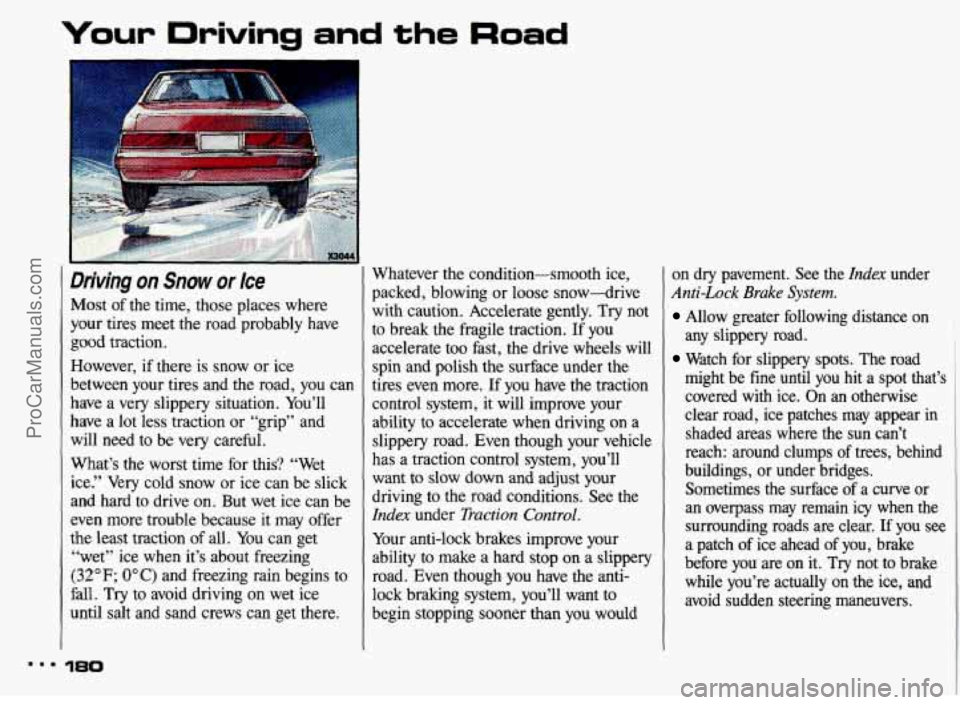
Your Driving and the Road
Driving on Snow or Ice
Most of the time, those places where
your tires meet the road probably have
good traction.
However, if there
is snow or ice
between your tires and the road, you can
have a
very slippery situation. You’ll
have a lot
less traction or “grip” and
will need to be very
careful.
What’s the worst time for this? “Wet
ice.”
Very cold snow or ice can be slick
and hard to drive on. But wet ice can
be
even more trouble because it may offer
the least traction of all. You can get
“wet” ice when it’s about freezing
(32°F; OOC) and freezing rain begins to
fall.
Try to avoid driving on wet ice
until salt and sand crews can get there. Whatever
the condition-smooth ice,
packed, blowing or loose snow-drive
with caution. Accelerate gently.
Try not
to break the fragile traction.
If you
accelerate too fast, the drive wheels will
spin and polish the surface under the
tires even more.
If you have the traction
control
system, it will improve your
ability to accelerate when driving on a
slippery road. Even though your vehicle
has a traction control system, you’ll
want
to slow down and adjust your
driving to the road conditions. See the
Index under Traction Control.
Your anti-lock brakes improve your
ability to make a hard
stop on a slippery
road. Even though you have the anti-
lock braking
system, you’ll want to
begin stopping sooner than you would on dry pavement. See the
Idex under
Anti-Lock Brake System.
Allow greater following distance on I
any slippery road.
Watch
for slippery spots. The road
might be fine until you
hit a spot that’s
covered with ice.
On an otherwise
clear road, ice patches may appear
in
shaded areas where the sun can’t
reach: around clumps
of trees, behind
buildings,
or under bridges.
Sometimes the surface of a
curve or
an overpass may remain icy when the
surrounding
roads are clear. If you see
a patch of ice ahead of you, brake
before you are on it.
Try not to brake
while you’re actually on the ice, and
avoid sudden steering maneuvers.
..I 180
ProCarManuals.com